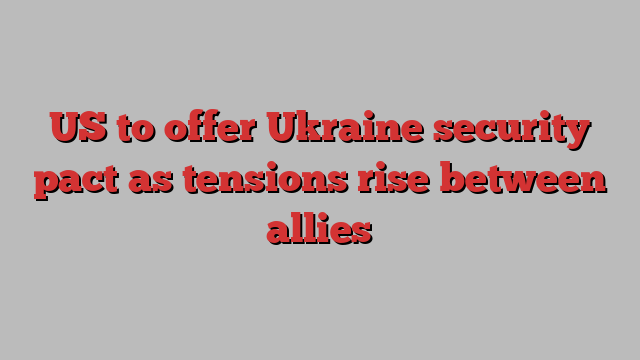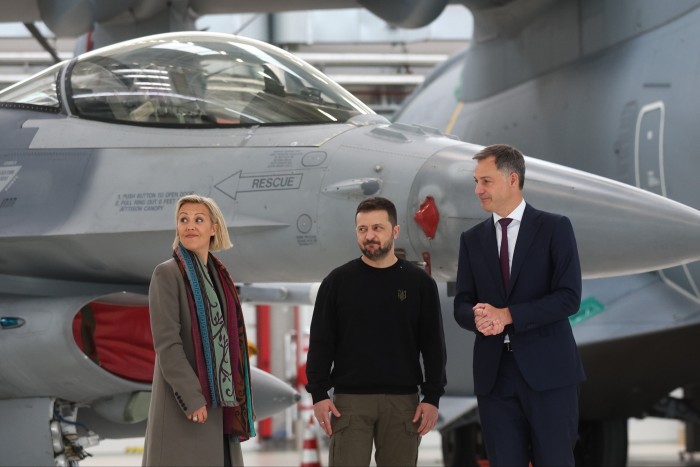
The US is close to signing a new bilateral security pact with Ukraine in a signal of support aiming to assuage Kyiv after “tense” relations that some Ukrainian officials say have hit their lowest ebb since Russia’s full-scale invasion.
The agreement would be the most significant in a series of deals Ukraine has struck with Nato countries that lays out commitments on long-term support, including military training, intelligence sharing and economic assistance.
Volodymyr Zelenskyy’s frustration with Joe Biden was laid bare this week, when the Ukrainian president rebuked his US counterpart in unusually blunt terms, saying Biden’s plan to attend a Democratic fundraiser rather than Ukraine’s peace summit on June 15-16 was “not a strong decision”.
One Zelenskyy-appointed senior government official who spoke to the Financial Times about the US-Ukraine relationship said: “We are farther apart than ever since the war started. It is very, very tense.”
However days before the peace summit, Zelenskyy and Biden are expected to sign a bilateral security agreement on the sidelines of the G7 meeting in Italy next month, US officials told the FT.
The pact has been negotiated during weeks of increasingly strained relations between Kyiv and Washington. Zelenskyy’s office this week issued a memo to officials and MPs, seen by the FT, that instructs them to criticise both Biden and Chinese President Xi Jinping for not attending the summit. “If they don’t [attend], then what is their real interest?” the memo wrote.
Several Ukrainian officials said that Kyiv’s bitterness over lack of top-level US support for its peace summit initiative was just one of many points of friction with Washington and other western partners that have erupted at a particularly difficult time for Ukraine’s leadership.
More than a dozen current and former Ukrainian officials and G7 country diplomats in Kyiv who spoke to the FT point to a clutch of contentious issues. These include Congress’s six-month delay in approving US military assistance; the expected lack of substantive progress towards Nato membership for Ukraine at the alliance’s Washington summit in July; the Biden administration’s prohibition on Kyiv’s use of American-supplied weapons inside Russia; and Ukraine’s drone strikes on Russian oil refineries.
Ukrainian attacks on two radar systems that form part of Moscow’s nuclear warning system over the past week have been a particular point of conflict with Washington, which is worried that it may provoke Moscow and further escalate the war.

Other points of concern include Zelenskyy’s little explained shake-ups of top government and military figures with whom the US worked closely, and diverging strategies on how Ukraine can achieve victory, as well as what that victory might look like.
Several Ukrainian government officials and diplomats from G7 nations cited the firing of commander-in-chief Valery Zaluzhny in February and infrastructure minister Oleksandr Kubrakov this month. Both men were well respected and enjoyed close working relationships with US and EU officials. The officials told the FT that G7 ambassadors have warned Zelenskyy’s government about what they see as disruptive and inexplicable moves.
The fraying relations and discord come as Ukrainian forces struggle to hold their defensive lines against a bigger and better-armed Russian army in the east, and while Zelenskyy is under huge pressure to mobilise more men and take other unpopular decisions to bolster the war effort.
Zelenskyy’s press secretary declined to comment on questions about relations with Biden’s White House.
The Biden administration has been among Ukraine’s most steadfast supporters, committing more than $175bn in emergency assistance to the country since the start of Russia’s all-out invasion in February 2022. Biden has repeatedly stated that the US would stick by Ukraine’s side for “as long as it takes”.
A US official said while there were points of disagreement in any bilateral relationship, there had been positive developments that had cheered officials in Kyiv. These include the US approval for Kyiv’s use of long-range 300km Atacms missiles and Congress passing $60bn of aid last month.
The US official also said Ukraine’s request to use US weapons to strike inside Russia was relatively recent, coming three weeks ago when Russian forces opened a new front in the north-eastern Kharkiv region. The official said the request is being evaluated by the Biden administration, suggesting a shift was possible soon.
But a second senior Ukrainian official said Zelenskyy has grown more “emotional and nervous” over the situation on the battlefield and what they say the president sees as Washington’s eagerness to start negotiations with Russia, despite the White House stating in public that it is entirely a decision for Kyiv to initiate such talks.
Zelenskyy “thinks they want the war to go away before the [US] election”, the official said. He added that the Ukrainian president was also unhappy with the Biden administration’s insistence that Kyiv not hit Russian oil infrastructure over fears of raising global gas prices in an election year.
A third senior Ukrainian official used the word “paranoia” to describe the feeling inside the presidential office in recent months, as Zelenskyy and his team have worked to prepare for next month’s peace summit. “Zelenskyy has deep anxiety about the military situation but especially about the peace summit in June,” the official said.

The Ukrainian president has tried to attract leaders from as many countries as possible to his summit in Switzerland, with the aim of uniting the global community against Vladimir Putin’s aggression. The Russian president has not been invited.
Representatives from more than 80 countries have confirmed their attendance, according to the memo and Zelenskyy. Meanwhile, Russia has been working to convince developing countries to sit it out.
Zelenskyy’s office wrote a memo on May 26 that outlines talking points for officials and MPs to use when speaking with western partners and media about the summit, and specifically instructs Ukrainian officials and lawmakers to pile public pressure on Biden and Xi.
“It is unlikely that the world will understand President Biden and President Xi if they do not join in the realisation of such undeniably just goals and bringing peace closer.”
Zelenskyy himself criticised the lack of response from the Biden administration during a visit to Brussels on Tuesday. “I am aware that America supports this summit, but we not aware on which level,” Zelenskyy said.
“I believe that the peace summit needs President Biden,” Zelenskyy continued. “His absence will only be a personal, standing applause to Putin.”
US officials say that Ukraine scheduled the summit in Switzerland for June 15 and 16 despite being told that Biden would probably be unable to attend. A senior official will represent the US at the meeting.
“The US and President Biden has been there for President Zelenskyy and for the people of Ukraine, and that will continue regardless of who sits in what chair at the peace summit,” White House National Security Council spokesperson John Kirby said on Wednesday.
Several members of Zelenskyy’s own government said they are beginning to worry about the methods employed by their president to communicate with the US. One said that Zelenskyy was “very irritated” with Biden, adding they were concerned about “openly provoking” the White House.
“What do you say in America?” a fourth Ukrainian government official asked the FT. “Do not bite the hand that feeds you.”

